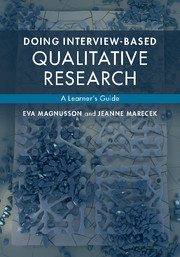Book contents
- Frontmatter
- Contents
- 1 Introduction
- 2 Some examples of interpretative research
- 3 Planning and beginning an interpretative research project
- 4 Making decisions about participants
- 5 Designing the interview guide
- 6 Doing the interview
- 7 Preparing for analysis
- 8 Finding meanings in people's talk
- 9 Analyzing stories in interviews
- 10 Analyzing talk-as-action
- 11 Analyzing for implicit cultural meanings
- 12 Reporting your project
- Epilogue
- References
- Index
2 - Some examples of interpretative research
Published online by Cambridge University Press: 05 October 2015
- Frontmatter
- Contents
- 1 Introduction
- 2 Some examples of interpretative research
- 3 Planning and beginning an interpretative research project
- 4 Making decisions about participants
- 5 Designing the interview guide
- 6 Doing the interview
- 7 Preparing for analysis
- 8 Finding meanings in people's talk
- 9 Analyzing stories in interviews
- 10 Analyzing talk-as-action
- 11 Analyzing for implicit cultural meanings
- 12 Reporting your project
- Epilogue
- References
- Index
Summary
One of the best ways to learn about interpretative research is to get acquainted with some actual projects. In this chapter, we describe five projects. Our intention is to show what the researchers were interested in, how they specified what they wanted to study in order to make it researchable, how they gathered their material, some examples of analyses, and some findings that the projects yielded. The projects we describe concern diverse topics, locales, and peoples: childrearing practices in the USA and Taiwan; repeated re-hospitalizations of people in the USA who had severe mental illnesses; how heterosexual couples in the Nordic countries make sense of gender-equal practices in daily life; Canadian women's accounts of their depressive experiences; and the spiral of suicide-like behavior among adolescent girls in Sri Lanka.
We have two reasons for presenting these projects. First, we want to give a sense of what interpretative research is like; for instance, how such projects might be structured and the kinds of questions that researchers can answer. Second, we use some of these projects as examples when we describe different ways of analyzing interviews. Before you read further, let us point out that these five studies do not cover all types of interpretative research. The selected studies illustrate some possibilities of such research, not all such possibilities.
As you will see, two of the project descriptions in this chapter stem from studies in which one of us was the researcher. We do not include these studies because they are necessarily the best examples of interpretative research, but rather because we have full knowledge of all the details, including details that normally are not described in research articles. (Quite a lot of what goes on in research is omitted in research publications.) Furthermore, we have extensive material from these studies, including, for example, interview transcripts, our research journals, and unpublished reports.
Information
- Type
- Chapter
- Information
- Doing Interview-based Qualitative ResearchA Learner's Guide, pp. 10 - 26Publisher: Cambridge University PressPrint publication year: 2015
